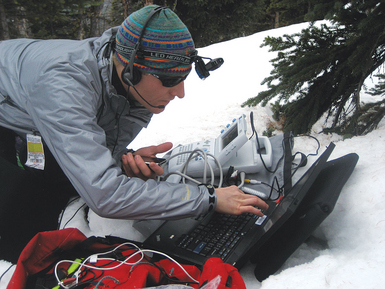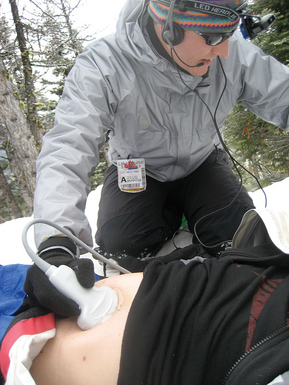Integrating ultrasound in emergency prehospital settings
A prospective evaluation in a hospital environment, determined that handheld focused assessment sonography in trauma (HHFAST) examination was equivalent to the FAST examination, using more conventional equipment. HHFAST had a sensitivity of 78%, specificity of 100%, positive predictive value (PPV) of 100%, and negative predictive value (NPV) of 97%.1,2 HHFAST can detect intraperitoneal fluid with high degrees of accuracy. It will miss some injuries, but the majority of injuries missed do not require therapy.3 In addition, field US, using the HHFAST, can also be performed by nonphysician providers. With close supervision, paramedics can adequately obtain and interpret FAST and abdominal aortic US images under protocol.4
Remote location imaging
Popov et al5 set out to demonstrate both the simplicity and robustness of existing US technologies in a remote location. They evaluated telementored resuscitative extended FAST (e-FAST) US examination. An expert interpreter guided a first responder located midmountain at a commercial ski resort. The test subject was a healthy volunteer. US images were obtained on a first-generation SonoSite 180 machine and were converted to digital video using a readily available video converter. A head-mounted camera provided a macroscopic view of the examination, allowing the remote examiner to view both the patient and examiner’s hands, while simultaneously viewing the US results (Figures 48-1 and 48-2).6–8
Remote US has also been evaluated and tested aboard Aquarius, an underwater habitat off the Florida Keys, as part of the NASA Extreme Environment Mission Operations (NEEMO). The life sciences mission NEEMO 7 investigated the role of US examination of the abdominal organs and structures. US-trained and untrained aquanaut crew members conducted a series of diagnostic and interventional procedures with remote guidance from experts more than 3000 km away. Researchers demonstrated that mean efficiencies were slightly higher with telementoring than with the use of a procedure manual.9
Disaster and prehospital medicine
The role of US in disaster medicine has not been well established and is generally limited to case reports and case series. A report by the Disaster Medical Assistance Team (DMAT), responding to the aftermath of a cyclone in Western Australia, demonstrated that US-competent physicians were able to use portable US on casualties to exclude intraabdominal hemorrhage, pericardial fluid, pneumothoraces, and hemothoraces. The US machine had a weight of 3.7 kg (MicroMaxx, SonoSite, Bothell, WA). It was powered by using a self-contained, rechargeable battery. A 60-mm, 5-2-MHz curvilinear probe and a 38-mm, 10-5-MHz linear probe were selected as most appropriate for the likely requirements. Information obtained using US made initial patient management and subsequent decisions regarding triage for transport safer and based on more detailed clinical information.10,11
Sarkisian et al12 reported from the Armenian earthquake of 1988, in which US was performed as a primary screening procedure in 400 of 750 mass casualty patients with trauma who were admitted to a large hospital within the first 72 hours after the earthquake. Two real-time sector scanners were used in the reception area of the hospital, and the average time spent on one patient was 4 minutes. More than 130 follow-up ultrasonographic examinations were required. Impressively, trauma-associated pathology of the abdomen and retroperitoneal space was detected in 12.8% of the patients, with 1% false negatives and no false positives.
In the Marmara earthquake, which occurred on August 17, 1999, 639 people had renal complications and 477 needed hemodialysis treatment because of acute renal failure caused by crush injury. This led Keven et al13









